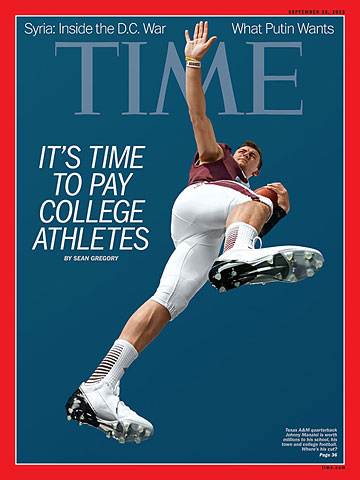It’s Time to Pay College Athletes
< < Go Back
by Sean Gregory,
 Should this kid be making $225,047 a year for playing college Football?
Should this kid be making $225,047 a year for playing college Football?
That’s what he’s worth, at least. Athletes at big-time football schools are cheap labor who bring in millions.
It’s time they got paid for their work.
The historic justification for not paying players is that they are amateur student-athletes and the value of their scholarships–often worth in excess of $100,000 over four years–is payment enough. But a growing number of economists and sports experts are beginning to argue for giving athletes a fair share of the take. The numbers are too large to ignore. College athletes are mass-audience performers and need to be rewarded as such. “The rising dollar value of the exploitation of athletes,” says Roger Noll, a noted sports economist from Stanford University, “is obscene, is out of control.”
According to the most recent federal data, the University of Texas football team netted a profit of $77.9 million in 2011–12, on $103.8 million in revenue. Michigan made $61.6 million from football, on $85.2 million in revenue. Any business would kill for those profit margins.
In fairness, many college athletes are compensated–with an athletic scholarship. This attractive carrot drives today’s intense competition in youth and high school sports. With tuition costs escalating, these scholarships are a serious meal ticket and for many families are the only way their children can afford to go to a four-year school.
Most scholarships are revokable, so if an athlete doesn’t perform well on the field, he can, in a sense, be fired from college. During football season, former Georgia tailback Richard Samuel, who earned an undergraduate degree in sports management in 2011, said he was an “athlete-student,” not a “student-athlete,” as the NCAA wants people to believe.
Players are essentially working full-time football jobs while going to school; they deserve to be paid more than a scholarship. Because even full-ride athletic scholarships don’t cover the full cost of attending school … Some athletes are on only partial scholarship or are walk-ons still paying full tuition.
While many players scrimp, their head coaches don’t. Average salaries for major college football coaches have jumped more than 70% since 2006, to $1.64 million, according to USA Today. “It’s nuts”.
Reforming college sports won’t be simple. Paying only men, for example, could face a challenge under Title IX, the federal law requiring gender equity in sports.
“Amateurism is under attack,” says Gabe Feldman, director of Tulane University’s sports-law program. “There’s an incentive for schools to redesign the model themselves rather than have the Congress or the courts do it for them.”
Paying players has risks. Richer schools could buy up talent and disrupt competitive balance. Alumni and fans could be turned off by an even more professionalized game. Paying players could make even more of a mockery of education.
More From TIME Magazine:



